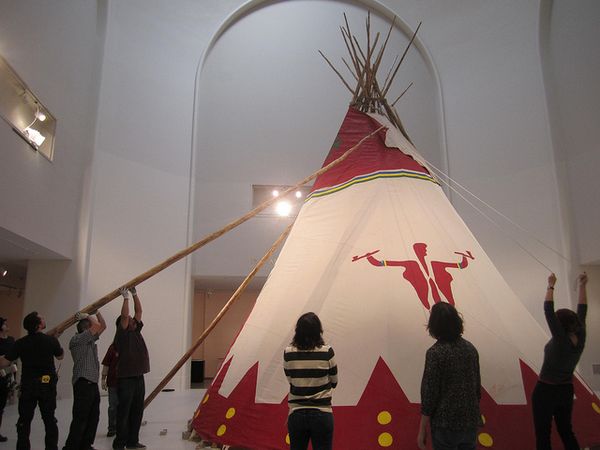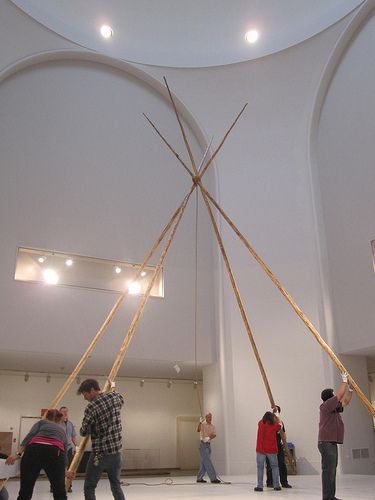So How Do You Set Up a Tipi?
That’s exactly the question we were asking ourselves when Nancy Rosoff and Susan Kennedy Zeller organizing Curators for Tipi: Heritage of the Great Plains put not one but four tipis on the checklist. The exhibition opens February 18, 2011 continuing to May 15 and includes not only tipis but objects used in and around tipis, such as clothing, weapons, bags, and toys. The four tipis in the exhibition are: a contemporary canvas Crow child’s tipi made by Trapline Lodges, a Sioux buffalo hide tipi commissioned from Ken Woody, a circa 1904 Cheyenne beaded tipi made by Imogene Whitebull in the collection of the Milwaukee Public Museum, and a 28 foot Blackfoot welcome tipi made by Lyle Heavy Runner. The public will be able to enter the welcome tipi to experience what it feels like and get a sense of what it might be like to live inside a tipi.

Blackfeet Tipi during final moments of installation.
So, this brings us back to the question: How do we set up a tipi, safely, and indoors? To paraphrase a quote by Filippo Gentile the Museum’s supervisor in-charge of the art handlers during installations, who would bear the brunt of making this installation happen – We are city people. What do we know of the country? Through a team effort involving Katie Welty the Registrar in charge of the exhibition, objects conservators, and art handlers, we managed to work out the details, consulting historic texts such as Indians of the Plains by Robert Lowie, and The Indian Tipi: Its History, Construction, and Use by Reginald and Gladys Laubin, as well as getting instructions from Ken Woody and Lyle Heavy Runner.

Blackfoot tipis have 4 foundation poles.
Tipis may look the same to you or me, but they are very different depending on which tribe made them. The most significant difference has to do with the number of tripod poles used to form the main structural support for the covering. I came to realize this in a phone conversation with Lyle Heavy Runner before he made an initial trip from Montana out to Brooklyn to do a test installation with us. Lyle kept referring to the four poles of the tripod, and I kept thinking, but doesn’t a tripod indicate three? Blackfoot and Crow tipis have 4 foundation poles, while the Sioux and Cheyenne use three foundation poles.

Test installation in October 2010.
Lyle’s visit for the test set up in October, 2010 was enlightening and frightening at the same time. Lyle had never set up a tipi indoors and we had never set up a tipi! At 28 feet tall, this was certainly a challenging one to start with.
After turning off the smoke detectors, Lyle smudged the tipi and us as a blessing before we started. In turns out we really needed it. After an intensive 2 days of work, the foundation poles broke and the tipi came crashing down onto the marble floor. No one was hurt. The blessing had worked. Lyle went home, leaving us with an introduction and the confidence in us that we could make this work.
New, thicker poles made from Lodgepole Pine were obtained from Montana and we set anew to learn how to erect a tipi. Knowing that the marble floor of the 5th floor Rotunda was working against us, the museum’s carpenters headed by Greg Battersby worked diligently to provide us a platform into which chock blocks could be attached to secure the poles.
A full week was set aside to work out the details of setting up three pole and four pole tipis. Lyle noted during his visit that the thought process of building was very different between native and non-native peoples. His thought process as a Blackfoot was to think of the whole first and then break it apart, whereas ours was very clearly building from the ground up, piece by piece to get a whole. Using the historic directions from the literature, and our experience with Lyle as a starting place, we set about coming up with directions for each tipi so that we could do this without a hitch when the installation started.
Everyone pooled together; Filippo looking at what the Eagle Scouts had written on erecting tipi’s, and refreshing his knowledge of basic geometry, and Assistant Objects Conservator Jakki Godfrey and Katie poured over a small model made from chopsticks to make sure the written directions were accurate. The week was intense. Looking up a 28 foot pole, one tends to experience vertigo, which is especially problematic when the pole weighs nearly 75 pounds! There were many intense discussions that week – “Which pole does this one go on top of? What do you mean by ‘on top’? Which “V”? There are at least six “V” shapes at the top of the poles! – but with the North, South, East and West quadrants marked out on the four walls of the gallery with blue tape, we managed to do it.
Armed with templates, and fully labeled poles – NW, SW, NW, NE foundation poles, support poles 1-14, ear flap or smoke flap poles, and chock blocks – we managed to put up Lyle Heavy Runner’s Blackfoot Welcome Tipi. It may not have been as a member of the Blackfoot nation would have done it, but it was all Brooklyn!
I hope you enjoy the experience of being inside when you come see the exhibition.

Lisa Bruno is the head conservator of objects at the Brooklyn Museum, where she has been working since 1993. She has previously worked at the Art Institute of Chicago, and has had internships at The Cleveland Museum of Art, the Detroit Institute of Arts, and in private practice. She has a Masters Degree in Art Conservation from the University of Delaware, Winterthur Museum Art Conservation Department. She is a Professional Associate of the American Institute for Conservation.
